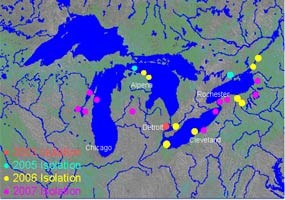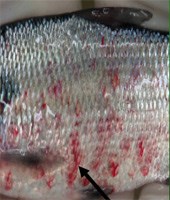|
What is VHS and VHSv? Viral Hemorrhagic Septicemia (VHS) is a fish disease that can cause large-scale mortality and has been detected in 32 species of fish in the lower Great Lakes since 2003. The virus that causes the disease (VHSv) has not been found yet in Lake Superior. VHSv can infect a wide range of fish species and has been the cause of large fish kills in other parts of the Great Lakes. Great Lakes fish have no prior exposure to VHSv and, therefore, are especially susceptible to the disease. In fact, according to Dr. Gael Kurath, U.S. Geological Survey virologist, there has not been a virus in the past that has affected so many fish species from so many fish families in the Great Lakes. VHS does not pose a threat to human health. 
All waters within the Lake Superior basin are at immediate risk for VHS introduction, including those of Pictured Rocks National Lakeshore, Isle Royale National Park, Apostle Islands National Lakeshore, and the Grand Portage Band of Lake Superior Chippewa Reservation, which contains the Grand Portage National Monument within its reservation boundaries. These parks contain some of the most productive fisheries in the basin and may include populations of coaster brook trout, cisco, and unique morphotypes of lake trout at Isle Royale. VHS can cause large fish kills, reducing important recreational opportunities, subsistence and commercial fish stocks, alter food webs and age structures of fish populations, and create unpleasant conditions such as windrows of dead fish.
What can the National Park Service do about VHS? The four units of the National Park System on Lake Superior and the Grand Portage Band of the Lake Superior Chippewa have developed a plan to protect park and tribal fishery resources from VHS. At Pictured Rocks National Lakeshore, the Superintendent has issued Emergency Restrictions (1) prohibiting ballast water exchange, (2) prohibiting the use of fish parts as bait, and (3) requiring boat decontamination.
What is the focus of this Plan? This plan is focused on (1) preventing contamination of the waters of the four units of the National Park System located in the Lake Superior basin and the Grand Portage Indian Reservation, (2) detecting the introduction of VHSv, and (3) responding to VHSv detection and outbreaks. The plan will assist park and tribal managers, staff, and cooperators in assessing the risk of VHSv introduction and, subsequently, planning and implementing the appropriate levels of prevention and monitoring actions for their area based upon that risk. The plan also provides a framework for response. Implementation of this plan will require close coordination with tribes; federal, state, and provincial agencies; and other organizations as they implement their own plans around the basin. 
Photo: Dr. Mohamed Faisal, Michigan State University There is the potential for catastrophic loss of species important for recreational, subsistence, and commercial fishing opportunities, as well as potential impacts to prey species that could affect higher levels of the food web within Lake Superior. Any loss of stocks from the Apostle Islands area and Isle Royale could cause a loss of genetic material and valuable information that would compromise ongoing efforts to restore lake trout populations in the other Great Lakes. There is also a potential for loss of Isle Royale coaster brook trout populations from which eggs and milt are collected to create brood stock in hatcheries that enhance the overall sustainability of coaster brook trout populations and lake-wide restoration efforts. The plan identifies emergency response actions that are essential to implement prior to the beginning of the spring spawning, recreational fishing, and shipping seasons on Lake Superior in order to fulfill the resource protection mandates of the National Park Service and the Grand Portage Band.
What are the major elements of this plan? This plan includes an analysis of the risks posed by the various pathways (or vectors) for transmission of the virus, a listing of known measures to prevent or contain the virus, an overall plan for the prevention of or response to the virus in the four National Park System units and the Grand Portage Indian Reservation, and recommendations for enhancing cooperation with tribes, agencies, and other organizations. Emergency recommendations for the parks and the Grand Portage Band include an outreach campaign, boat decontamination, restrictions on the use of bait, and ensuring that agency operations and practices do not spread the virus, including agency-controlled vessel ballast water. All of these actions will be implemented in close coordination and collaboration with the respective tribal and state regulatory agencies. Longer-term, non-emergency recommendations include research, enforcement of laws and regulations, collaborating with the U.S. Coast Guard and the states and commenting on the development of their ballast water regulations, engaging with other stakeholders on aquatic invasive species prevention measures and the harmonization of regulations amongst agencies, conducting pre-infection fisheries assessments, and working with other stakeholders to conduct a detailed risk assessment.
What are the next steps? The National Park Service will request that the states impose emergency regulatory action to protect park fisheries resources. Should that not be possible in the emergency timeframe, the NPS and the Grand Portage Band will collaborate with the states but will act within their authorities. Consultation and collaboration will be essential elements of all efforts to prevent and respond to VHSv. As knowledge and technologies improve, actions will be evaluated and refined. We will only succeed at preventing VHSv in Lake Superior by recognizing that tribal, federal, state, and private interests must work in concert, and as rapidly as possible.
Resources on the web www.michigan.gov/dnr/ (click Fishing, Fish Disease, VHS) www.focusonfishhealth.org |
Last updated: August 20, 2021
